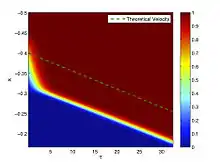Fisher's equation
In mathematics, Fisher's equation (named after statistician and biologist Ronald Fisher) also known as the Kolmogorov–Petrovsky–Piskunov equation (named after Andrey Kolmogorov, Ivan Petrovsky, and N. Piskunov), KPP equation or Fisher–KPP equation is the partial differential equation:


It is a kind of reaction–diffusion system that can be used to model population growth and wave propagation.
Details
Fisher's equation belongs to the class of reaction–diffusion equation: in fact, it is one of the simplest semilinear reaction-diffusion equations, the one which has the inhomogeneous term
which can exhibit traveling wave solutions that switch between equilibrium states given by . Such equations occur, e.g., in ecology, physiology, combustion, crystallization, plasma physics, and in general phase transition problems.
Fisher proposed this equation in his 1937 paper The wave of advance of advantageous genes in the context of population dynamics to describe the spatial spread of an advantageous allele and explored its travelling wave solutions.[1] For every wave speed ( in dimensionless form) it admits travelling wave solutions of the form
where is increasing and
That is, the solution switches from the equilibrium state u = 0 to the equilibrium state u = 1. No such solution exists for c < 2.[1][2][3] The wave shape for a given wave speed is unique. The travelling-wave solutions are stable against near-field perturbations, but not to far-field perturbations which can thicken the tail. One can prove using the comparison principle and super-solution theory that all solutions with compact initial data converge to waves with the minimum speed.
For the special wave speed , all solutions can be found in a closed form,[4] with
where is arbitrary, and the above limit conditions are satisfied for .
Proof of the existence of travelling wave solutions and analysis of their properties is often done by the phase space method.
Fisher–Kolmogorov equation
A generalization is given by
which gives the above equation upon setting , and rescaling the coordinate by a factor of .[5][6][7]
References
- Fisher, R. A. (1937). "The Wave of Advance of Advantageous Genes" (PDF). Annals of Eugenics. 7 (4): 353–369. doi:10.1111/j.1469-1809.1937.tb02153.x. hdl:2440/15125.
- A. Kolmogorov, I. Petrovskii, and N. Piskunov. "A study of the diffusion equation with increase in the amount of substance," and its application to a biological problem. In V. M. Tikhomirov, editor, Selected Works of A. N. Kolmogorov I, pages 248–270. Kluwer 1991, ISBN 90-277-2796-1. Translated by V. M. Volosov from Bull. Moscow Univ., Math. Mech. 1, 1–25, 1937
- Peter Grindrod. The theory and applications of reaction-diffusion equations: Patterns and waves. Oxford Applied Mathematics and Computing Science Series. The Clarendon Press Oxford University Press, New York, second edition, 1996 ISBN 0-19-859676-6; ISBN 0-19-859692-8.
- Ablowitz, Mark J. and Zeppetella, Anthony, Explicit solutions of Fisher's equation for a special wave speed, Bulletin of Mathematical Biology 41 (1979) 835–840 doi:10.1007/BF02462380
- Trefethen (August 30, 2001). "Fisher-KPP Equation" (PDF). Fisher 2.
- Griffiths, Graham W.; Schiesser, William E. (2011). "Fisher–Kolmogorov Equation". Traveling Wave Analysis of Partial Differential Equations. Academy Press. pp. 135–146. ISBN 978-0-12-384652-5.
- Adomian, G. (1995). "Fisher–Kolmogorov equation". Applied Mathematics Letters. 8 (2): 51–52. doi:10.1016/0893-9659(95)00010-N.
External links
- Fisher's equation on MathWorld.
- Fisher equation on EqWorld.